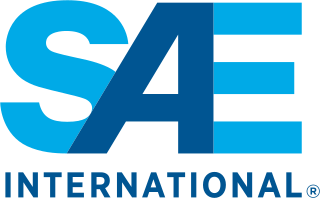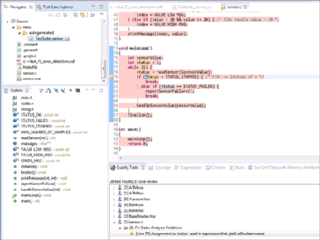Related Research Articles

Safety engineering is an engineering discipline which assures that engineered systems provide acceptable levels of safety. It is strongly related to industrial engineering/systems engineering, and the subset system safety engineering. Safety engineering assures that a life-critical system behaves as needed, even when components fail.

A safety-critical system or life-critical system is a system whose failure or malfunction may result in one of the following outcomes:
DO-178B, Software Considerations in Airborne Systems and Equipment Certification is a guideline dealing with the safety of safety-critical software used in certain airborne systems. It was jointly developed by the safety-critical working group RTCA SC-167 of the Radio Technical Commission for Aeronautics (RTCA) and WG-12 of the European Organisation for Civil Aviation Equipment (EUROCAE). RTCA published the document as RTCA/DO-178B, while EUROCAE published the document as ED-12B. Although technically a guideline, it was a de facto standard for developing avionics software systems until it was replaced in 2012 by DO-178C.
In functional safety, safety integrity level (SIL) is defined as the relative level of risk-reduction provided by a safety instrumented function (SIF), i.e. the measurement of the performance required of the SIF.
A hazard analysis is used as the first step in a process used to assess risk. The result of a hazard analysis is the identification of different types of hazards. A hazard is a potential condition and exists or not. It may, in single existence or in combination with other hazards and conditions, become an actual Functional Failure or Accident (Mishap). The way this exactly happens in one particular sequence is called a scenario. This scenario has a probability of occurrence. Often a system has many potential failure scenarios. It also is assigned a classification, based on the worst case severity of the end condition. Risk is the combination of probability and severity. Preliminary risk levels can be provided in the hazard analysis. The validation, more precise prediction (verification) and acceptance of risk is determined in the risk assessment (analysis). The main goal of both is to provide the best selection of means of controlling or eliminating the risk. The term is used in several engineering specialties, including avionics, food safety, occupational safety and health, process safety, reliability engineering.

ARP4754, Aerospace Recommended Practice (ARP) ARP4754B, is a guideline from SAE International, dealing with the development processes which support certification of Aircraft systems, addressing "the complete aircraft development cycle, from systems requirements through systems verification." Revision A was released in December 2010. It was recognized by the FAA in AC 20-174 published November 2011. EUROCAE jointly issues the document as ED–79.
IEC 61508 is an international standard published by the International Electrotechnical Commission (IEC) consisting of methods on how to apply, design, deploy and maintain automatic protection systems called safety-related systems. It is titled Functional Safety of Electrical/Electronic/Programmable Electronic Safety-related Systems.
IEC standard 61511 is a technical standard which sets out practices in the engineering of systems that ensure the safety of an industrial process through the use of instrumentation. Such systems are referred to as Safety Instrumented Systems. The title of the standard is "Functional safety - Safety instrumented systems for the process industry sector".
In software engineering, software system safety optimizes system safety in the design, development, use, and maintenance of software systems and their integration with safety-critical hardware systems in an operational environment.
In functional safety a safety instrumented system (SIS) is an engineered set of hardware and software controls which provides a protection layer that shuts down a chemical, nuclear, electrical, or mechanical system, or part of it, if a hazardous condition is detected.
MISRA C is a set of software development guidelines for the C programming language developed by The MISRA Consortium. Its aims are to facilitate code safety, security, portability and reliability in the context of embedded systems, specifically those systems programmed in ISO C / C90 / C99.
Spurious trip level (STL) is defined as a discrete level for specifying the spurious trip requirements of safety functions to be allocated to safety systems. An STL of 1 means that this safety function has the highest level of spurious trips. The higher the STL level the lower the number of spurious trips caused by the safety system. There is no limit to the number of spurious trip levels.

LDRA is a provider of software analysis, test, and requirements traceability tools for the Public and Private sectors. It is a pioneer in static and dynamic software analysis.
ISO 26262, titled "Road vehicles – Functional safety", is an international standard for functional safety of electrical and/or electronic systems that are installed in serial production road vehicles, defined by the International Organization for Standardization (ISO) in 2011, and revised in 2018.
TargetLink is a software for automatic code generation, based on a subset of Simulink/Stateflow models, produced by dSPACE GmbH. TargetLink requires an existing MATLAB/Simulink model to work on. TargetLink generates both ANSI-C and production code optimized for specific processors. It also supports the generation of AUTOSAR-compliant code for software components for the automotive sector. The management of all relevant information for code generation takes place in a central data container, called the Data Dictionary.

Parasoft C/C++test is an integrated set of tools for testing C and C++ source code that software developers use to analyze, test, find defects, and measure the quality and security of their applications. It supports software development practices that are part of development testing, including static code analysis, dynamic code analysis, unit test case generation and execution, code coverage analysis, regression testing, runtime error detection, requirements traceability, and code review. It's a commercial tool that supports operation on Linux, Windows, and Solaris platforms as well as support for on-target embedded testing and cross compilers.
Automotive Safety Integrity Level (ASIL) is a risk classification scheme defined by the ISO 26262 - Functional Safety for Road Vehicles standard. This is an adaptation of the Safety Integrity Level (SIL) used in IEC 61508 for the automotive industry. This classification helps defining the safety requirements necessary to be in line with the ISO 26262 standard. The ASIL is established by performing a risk analysis of a potential hazard by looking at the Severity, Exposure and Controllability of the vehicle operating scenario. The safety goal for that hazard in turn carries the ASIL requirements.
Hercules is a line of ARM architecture-based microcontrollers from Texas Instruments built around one or more ARM Cortex cores. This "Hercules safety microcontroller platform" includes a series of microcontrollers specifically targeted for Functional Safety applications, through such hardware-base fault correction/detection features as dual cores that can run in lock-step, full path ECC, automated self testing of memory and logic, peripheral redundancy, and monitor/checker cores.
Cantata++, or simply Cantata in newer versions, is a commercial computer program for dynamic testing, specifically unit testing and integration testing, and code coverage at run time of C and C++ programs. It is developed and sold by QA Systems, and was formerly a product of IPL Information Processing Ltd.
High-integrity software is software whose failure may cause serious damage with possible "life-threatening consequences." "Integrity is important as it demonstrates the safety, security, and maintainability of... code." Examples of high-integrity software are nuclear reactor control, avionics software, automotive safety-critical software and process control software.
[H]igh integrity means that the code:
References
- ↑ Van Beurden, Iwan (November 2017). "Safety Instrumented Function Verification: The Three Barriers" (PDF). exida.
- ↑ "RADA Sense - Shower T3" (PDF). Rada. 2008. Archived from the original (PDF) on 2011-07-15. Retrieved 2009-07-25.
- ↑ "IEC 61508 Safety Case Example: Diving Equipment". Deep Life. Archived from the original on 2016-03-03. Retrieved 2013-01-22.
- ↑ "Industrial IT System 800xA High Integrity". ABB.
- ↑ "IEC 61508 SIL 3 certified RTOS". Green Hills Software.
- ↑ "SAFETY AUTOMATION ELEMENT LIST". exida.
- ↑ V. Hilderman, T. Bagha, "Avionics Certification", A Complete Guide to DO-178B and DO-254, ISBN 978-1-885544-25-4
- ↑ C. Spritzer, "Digital Avionics Handbook, Second Edition - 2 Volume Set (Electrical Engineering Handbook", CRC Press. ISBN 978-0-8493-5008-5
- ↑ Lie, Simon (2014). In Service Safety at Boeing (PDF). Paper presented at ISASI 2014 Seminar, October 2014, Adelaide, Australia. ISASI.
- ↑ NASA Software Safety Standard NASA STD 8719.13A
- ↑ NASA-GB-1740.13-96, NASA Guidebook for Safety Critical Software.
- ↑ Nelson, Stacy (June 2003). "Certification Processes for Safety-Critical and Mission-Critical Aerospace Software" (PDF). NASA/CR–2003-212806.
- 1 2 "26262-1:2011". ISO. Retrieved 25 April 2013.